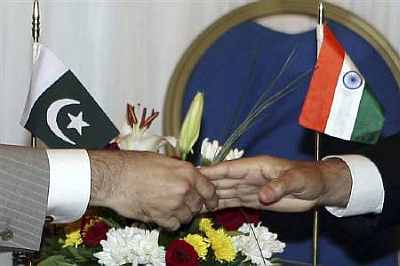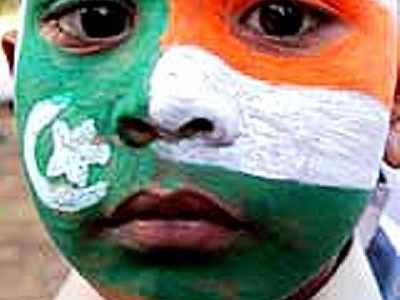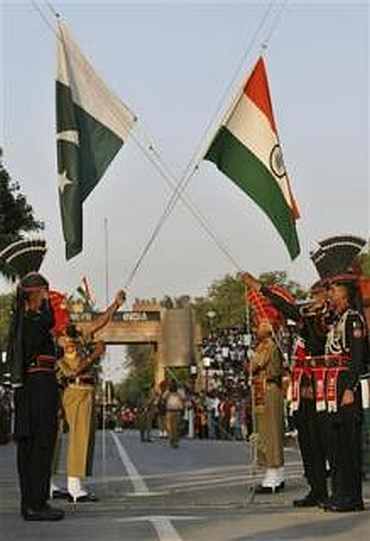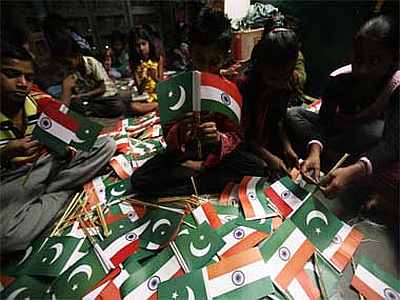Photographs: Reuters N Chandra Mohan
Political tensions have cast a long and troubled shadow over cooperation between India and Pakistan. Cross-border terrorism, Kashmir and water rights remain the core issues of contention.
Despite these hardy perennials, the good news of late is the determined, time-bound steps being taken by both nations to normalise trade relations.
In a spirit of better late than never, Pakistan has extended most favoured nation (MFN) status – a building block of trade whereby each country extends the same benefits to a country that it extends to all the others – to India, 15 years after India accorded the same status to Pakistan in 1996.
...
The rising tide of Indo-Pak trade
Photographs: Amr Abdallah Dalsh/Reuters
Bilateral trade volumes have been low since the discriminatory trade regime favoured by Pakistan till now permitted the import of only a limited number of items from India. To be sure, this positive list steadily kept going up from 600 items in 2000 to 1,934 items in 2009.
But this regime also led to large informal trade inflows: goods that did not figure in the list from India were routed through Singapore or Dubai and then onto Iran or Afghanistan before landing up in Pakistan. Official two-way trade, thus, remained below par at $2.7 billion in 2010-11 while informal trade was as high as $10 billion.
But times are changing with the granting of MFN status to India. Instead of a positive list, Pakistan has now announced a negative list of 1,209 tariff lines. Barring these items, all the rest – that can go as high as 7,800 items – can now be imported from India.
...
The rising tide of Indo-Pak trade
Photographs: Reuters
A complete phase-out of this negative list by end-2012 is subject to further negotiations between both the countries. Pakistan's long-standing demand that India reduce its non-tariff barriers has also been addressed through the initialling of three agreements; notably, customs cooperation, mutual recognition and reduction of trade grievances.
For bilateral trade to take off, India has decided, in principle, to allow foreign direct investments from Pakistan. The much-needed infrastructure has also been put in place with the integrated check post at the Attari-Wagah border becoming operational.
A roadmap has been agreed to widen the range of items that can be traded through this land route beyond the 137 items that are currently permitted. Both countries have also decided to fast-track talks for trade in petroleum products and electricity. The opening up of bank branches in each other's territory is being addressed on a top-priority basis.
...
The rising tide of Indo-Pak trade
Photographs: Mohsin Raza/Reuters
The upshot is that there is only one direction that bilateral trade can now go. Economists use gravity models, potential trade approaches and other techniques to estimate trade possibilities.
According to gravity models, the flow of trade between a pair of countries is proportional to their economic mass and inversely proportional to the distance between them.
Bilateral trade is positively a function of national income and negatively a function of distance. Indo-Pak trade could be about $6-7 billion or 2.5 times above existing trade levels, according to the latest estimate using the gravity model by the World Bank.
...
The rising tide of Indo-Pak trade
Photographs: Amiruddin/Reuters
Professor Nisha Taneja of the Delhi-based think-tank, Indian Council for Research on International Economic Relations, focuses first on identifying products having trade potential -- they must have adequate demand in the receiving country and adequate supply capabilities must exist in the source country.
Potential trade for any commodity is given by the minimum of the supplier's global exports and receiver's global imports minus the existing trade between the supplier and receiver. The exercise, that was conducted by first using Pakistan as a supplier and then using India as a supplier, indicated a much larger trade potential that was ten times larger than the current levels of trade.
Thus, with a two-way trade of $2.7 billion in 2010-11, the potential was as large as $25.2 billion (see Taneja's recent article "Most Favoured Nation: New Trade Opportunities for India and Pakistan" in the Economic and Political Weekly).
...
The rising tide of Indo-Pak trade
Photographs: Reuters
However, commerce ministry officials from both countries see only a modest doubling of trade to $6 billion over the next three years.
The big reason these numbers are sustainable is that bilateral volumes, especially since 2004-05, have steadily risen from $616 million to $2.7 billion despite the gravest political disturbances.
These events include the Samjhauta Express blasts in 2007, assassination of Benazir Bhutto in November 2007 and the Mumbai terror attacks of November 2008. The global economic crisis of 2008-09 did trigger a downtrend in bilateral trade but it recovered thereafter.
...
The rising tide of Indo-Pak trade
Photographs: Reuters
Taneja in an earlier paper "Issues in India-Pakistan Trade Negotiations" published in the Economic and Political Weekly, attributed the uptrend to the steady increase in Pakistan's positive list from 767 to 1,934 items; revision of the Maritime Protocol allowing third countries vessels to lift cargo originating from either India or Pakistan for other countries in 2005; opening of the Attari-Wagah border also in 2005; allowing cross-border truck movement in 2007.
To all of this must be added the time-bound adherence to achieve targets in the bilateral economic and commercial cooperation talks, which resumed from April 2011 onwards, to ensure normalised trade between the two countries beyond the shadow of politics.
From the Ivory Tower will make research from the academic world accessible to all our readers.









article